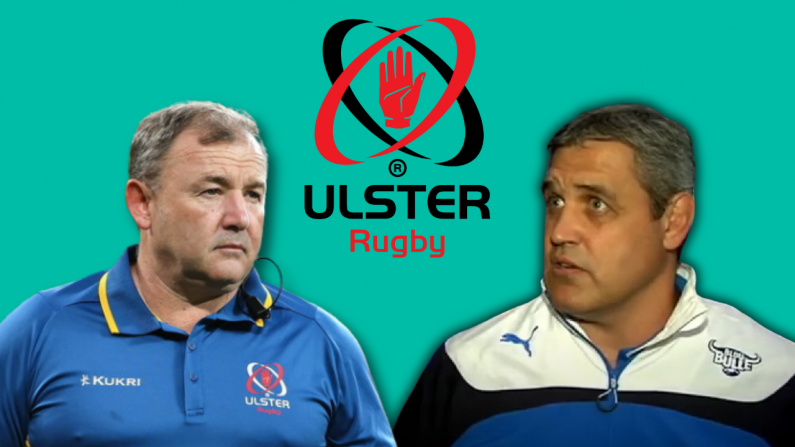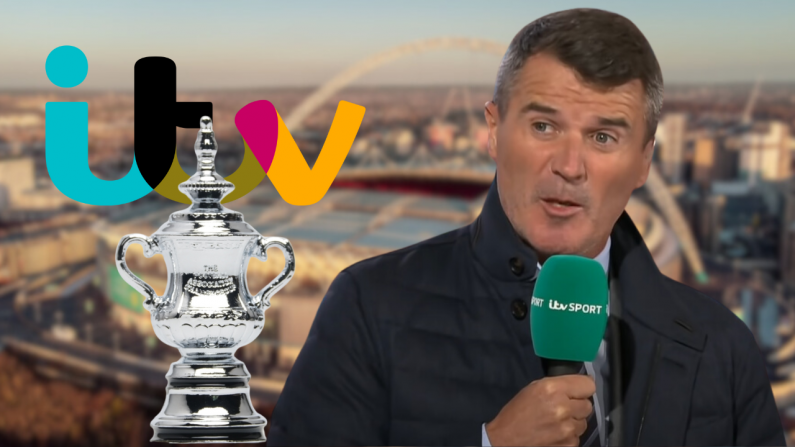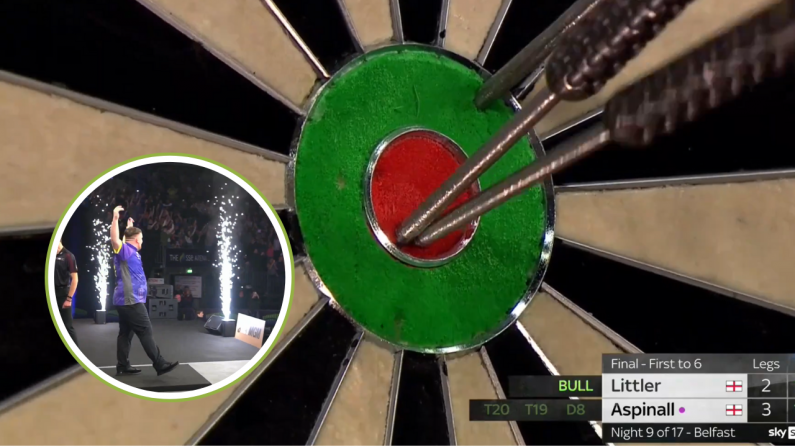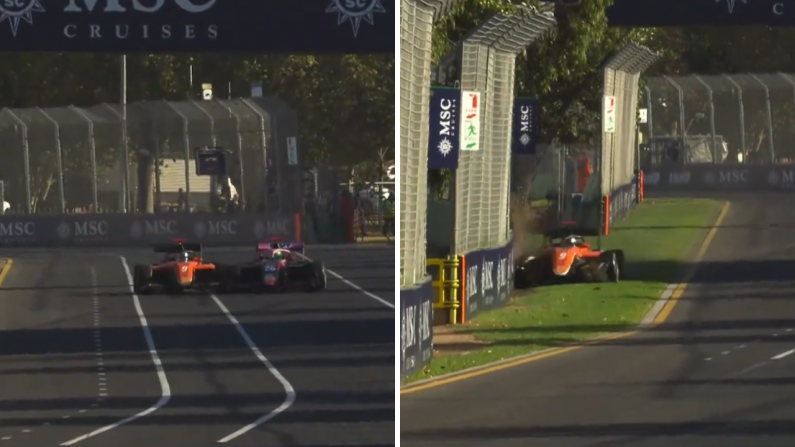The rules within sports are constantly changing, and often these alterations can be driven by one individual.
Be it instances of unsportsmanlike conduct, taking advantage of a loophole, or someone just figuring out something that others haven't, sometimes rule changes are inevitable.
Here are a few examples.
NOTE: Contrary to popular belief, the Sean Cavanagh tackle on Conor McManus in the 2013 All-Ireland quarter-final did not provide the inspiration for the black card. The black card had already been passed at Congress earlier that year and was set to debut in the 2014 season.
Italia 90 (honourable mention goes to Ireland 0-0 Egypt)
Until the year of our lord 1990, it was thought right and natural that a goalkeeper could pick up a ball in his penalty box, no matter what way it arrived at him.
It was the World Cup in Italy in 1990, famously the most negative tournament of them all, when panicky defenders - and midfielders - were officially deemed to have taken the piss with the back-pass.
And no team abused the back-pass more than Ireland, for whom Packie Bonner more often than not operated as a kind of deep lying playmaker. Ireland scored two goals in that magical summer, both of which originated from one of Packie's aerial bombs. Indeed, in both cases, he was the last Irish player to touch the ball in the move other than the goalscorer. So in that sense it was entirely logical that Ireland should feed their most creative player at every opportunity.
In his book 'The Outsider', football writer Jonathan Wilson specifically cited the Ireland-Egypt game as a match which highlighted the need for change in bright neon lettering.
Even in Ireland, the match is frequently touted as the worst game in World Cup history, largely thanks to the efforts of Eamon Dunphy. But who knew that the game would prove so instrumental in forcing the FIFA suits to recognise that change was needed?
A general rethink about the laws of the game had been prompted by the negativity of the 1990 World Cup and, in particular one passage of play in the group match between the Republic of Ireland and Egypt in which the Irish keeper Packie Bonner held the ball for almost six minutes without releasing it.
The new back-pass rule was eventually introduced in the summer of 1992. It first came into affect at the 1992 Olympics in Barcelona. According to the Guardian, German goalkeeper Bodo Illgner has the honour of being the last person to legally pick up a back-pass in a major competition. He picked up Stefan Reuter's back-pass in the dying seconds of the Euro 92 Final, where Germany trailed jammy surprise packages Denmark 2-0. Presumably, he didn't hold onto it long. Furthermore, they assert that Steve Nicol's pass back to Bruce Grobbelaar in the closing stages of the 1992 FA Cup Final is the final such instance in the English club game.
Here's one of the most stunning backpasses of all time, by Graeme Souness, then player-manager of Rangers in the 1987 European Cup.
Graeme Souness said Pogba won't change games. Here's the bloke hitting a 70 yard back pass to his keeper... pic.twitter.com/R3DQ3pxfHp
— Enda Higgins (@endahiggins88) August 8, 2016
Anthony Nash
One of the more obvious instances of a rule change being inspired by a specific player. So obvious, that the new penalty rule was universally referred to as 'The Nash Rule' throughout 2014.
Nash was so good at taking penalties that he was deemed a threat to opponents' safety. Players invariably advanced a few metres when taking a penalty but Nash had perfected the technique to such an extent that he was able to take it to wild extremes.
By scooping the ball way up in to the air, he was able to advance about 7 or 8 metres before striking the ball with his big bossed hurl. He typically ended up striking 21 metre frees on the 13 metre line.
It was a formidably difficult skill and it took impressive hand-eye co-ordination to be able to execute. The goalkeeper and his phalanx of defenders were helpless sitting ducks on the line.
The controversy emerged when ex-players began to shudder that these sitting ducks were not only helpless, they were in serious danger of injury. After one of Nash's more breathtaking and dramatic efforts in the first half of the 2013 All-Ireland final replay, when 11 players massed on the line were unable to prevent the score, co-commentator Michael Duignan said, "he's rising it into the 13 metre line. It's crazy. It's dangerous. But it's under the rules, he's well entitled to do it."
Nicky English vigorously argued for a change of the rules in his Irish Times column. Even Ger Cunningham, who served as a selector for Cork that year, said the following summer that the GAA would have to take action.
The rule-makers agreed and quickly moved to legislate the 'Nash penalty' out of existence. The original ruling insisted that penalties would have to be struck from outside the 20 metre line.
This dramatically reduced the success rate from penalties in the 2014 season, with Tipperary missing two in the drawn All-Ireland final. The Hurling Review Committee, chaired by Liam Sheedy, eventually produced a proper solution, whereby penalties would have be struck from the 20 metre line but that only the goalkeeper could stand on the line. It was originally predicted that penalty saves would become a thing of the past. Happily, the opposite was true, with the 2015 championship witnessing a series of fantastic saves from the likes of Colm Callanan and others.
The Fort Wayne Pistons v the Minneapolis Lakers
In 1949, the National Basketball League and the Basketball Association of America merged to form the National Basketball Association. The Minneapolis Lakers - the forerunner of the LA Lakers - dominated the competition in the early years, winning in NBA finals in five of the first six years.
The exception was the 1950-51 season, when the Rochester Royals, later the Sacramento Kings, took the title. That season, however, is best remembered for a game in the Minneapolis Auditorium on 22 November 1950.
The Lakers hosted the Fort Wayne Pistons, now known as the Detroit Pistons. The hosts hadn't lost at their own patch in over a year but the Pistons coach Murray Mendenhall had a plan.
Stew Thornley, in his history of the Lakers 1950s dynasty, described the less than frantic early exchanges.
Fort Wayne controlled the jump and (George) Mikan (Lakers' best player), flanked by Pollard and Mikkelsen, lumbered into defensive position. But as the trio turned around, they saw Pistons center Larry Foust standing at mid-court with the ball on his hip. And that’s where Foust—and the ball—stayed. Foust was under strict orders from Mendenhall to do nothing until the Lakers came out to play man- to-man.
The officials—Stan Stutz and Jocko Collins—screamed at Mendenhall and the Pistons to play ball. Mendenhall fired back that Minneapolis was playing an illegal zone defense, a charge that Lakers coach Kundla denied.
Meanwhile, the Auditorium crowd of 7,021 began to boo and stomp their feet in response to the inactivity. But Fort Wayne stuck to its game plan as they held the ball for as long as three minutes at a time. When one playing got tired of holding the ball, he’d flip it to a teammate, who would then tuck it under his arm.
Fort Wayne proceeded to hold on the the ball for most of the game, deliberately avoiding adventure throughout. The Lakers occasionally engineered turnovers which were followed brief spasms of action. At half-time, the Lakers led 13-11. The crowd's mood hovered somewhere between restless and furious.
Amazingly, the second half would witness even less scores. Despite being behind, Fort Wayne stuck doggedly to their tactics. The Lakers led 17-16 entering the final quarter. The teams exchanged solitary free throws and the Lakers then tried stalling tactics as the clock ran out.
But with 9 seconds left a Lakers pass went out of bounds. The Pistons broke with speed and the ball was fed to the breaking Foust, of all people, who scored off the rim. The Lakers had enough time left to try and frantic break but their last ditch shot hit off the rim and came out.
Fort Wayne won the match 19-18. It remains the lowest scoring game in NBA history.
"If that’s basketball, I don’t want any part of it," said Lakers coach John Kundla (a touch reminiscent of Eddie).
Mendenhall was unapologetic.
What was wrong with it? We won, didn’t we? We wanted to get those giants out in the open where we would have a chance to play basketball, not get our heads kicked in.
Sports columnists bemoaned the game as a sports tragedy but local Minneapolis Tribune columnist Dick Cullum, who might have been expected to whinge and carp, defended the victors. His defence took a stirringly philosophical turn.
"It is a low conception of sports to say that a team’s first duty is to give you a lot of senseless action instead of earnest competition."
The shot clock wasn't introduced until before the 1954-55 season but never again would there be a 'full game stall' in the NBA. Teams tended to reach a gentleman's agreement not to adopt such tactics. But this game has usually been cited as the inspiration and justification for the shot clock.
Padraig Harrington - in the groove
A rather arcane one here but we'll take Padraig's word for it. A fascinating interview with irksome Trump-licker, David Feherty. In 2010, the golfing authorities in the US decided to ban U-shaped box groove wedges. Players would have to stick with the less grooved V-shaped wedges.
The galleries and most of the rest of the golfing world reacted with a shrug. Not Padraig, who insists that the rule change robbed him of a competitive advantage. Unlike the rest of the field, Harrington recognised the worth of mixing and matching U and V shaped iron clubs.
Essentially, the box grooves (that's U-shaped grooves) allowed players to control the ball better in the rough. They would be able to impart spin on the ball, making the ball stop on the green even when hitting out of deep rough.
However, the V-grooves enabled players to hit the ball further in the rough. The corollary was players were less able to control the ball on the dancefloor and there was increased risk of fliers.
Harrington believes examples from his own game inspired the authorities to change the rules.
What's changed in my game was 2010, everything went downhill. The groove rule changed. I used the old groove rule to the absolute limit. I had the sharpest wedges out there. And the reason they changed the groove rule... I'd say six of the ten instances that changed their minds on the groove rule was me hitting shots, when I won in Mirasol, I hit a shot out of the rough. I still don't know how it stopped.
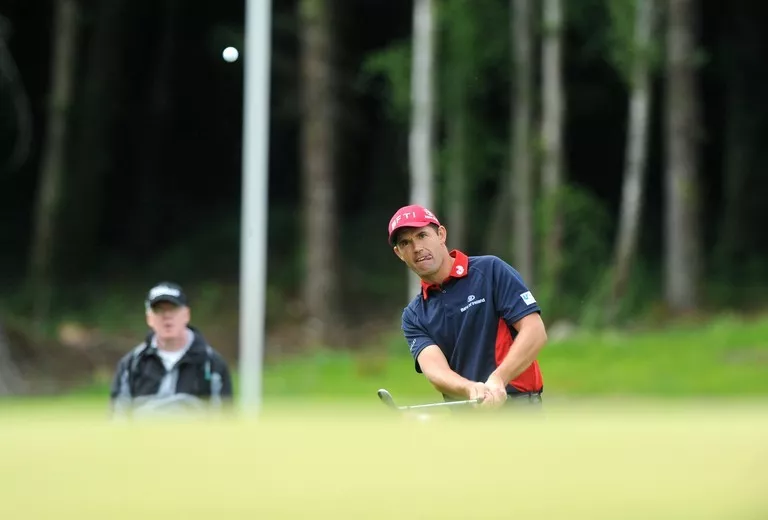
Ever the conscientious and analytical type, Harrington believes the changes were in the interests of the game, despite the supposedly negative influence on him.
Underarm bowling incident
It was natural that Eddie Jones, an Aussie, should lean on this comparison during his whinge last Sunday, even if the analogy was ridiculously overblown and somewhat slanderous to the Italians.
The underarm bowling incident of 1981 almost caused a diplomatic incident and now boasts its own wikipedia page.
Poor Trevor Chappell is almost solely remembered for the incident even if he was only carrying out the orders of his older brother, captain Greg.
Trevor explained in the video below that he can't tell anyone, be they a bloke in a pub or a representative from an insurance company, his name without the person responding "Oh! You're the underarm bloke!"
It was the final match of the 1981 Benson & Hedges World Series Cup. New Zealand and Australia were tied at 1-1 entering the final match. Entering the final over, New Zealand's lower order batsmen needed 15 runs to win. Trevor Chappell took 2 wickets for 8 runs in the first five balls of the over.
When they came to the last ball New Zealand needed an unfeasible 7 runs to win but six would deliver the draw.
The Australians decided to make sure they would not get this. Greg Chappell, who later blamed his decision on exhaustion, instructed his younger brother to roll the ball along the ground, making the six impossible.
Remarkably, this was still legal at the time, even if it was deemed incompatible with the spirit of the game. The New Zealanders were furious and not just the players.
The New Zealand prime minister Rob Muldoon delivered this rather intemperate verdict at a press conference that evening.
"I described Greg Chappell's actions as an act of cowardice, which I believe it was. And I thought it was most appropriate that the Australian team were dressed in yellow. I said it was the most disgusting episode I could recall in the history of cricket, a game which used to be played by gentlemen."
On Australian television that evening, former Aussie bowler and legendary commentator Richie Benaud labelled it "disgraceful" and said that he presumed that underarm bowling would be outlawed by tomorrow.
Underarm bowling was almost immediately banned from limited overs cricket by the ICC.
Douglas Jardine and the Bodyline Ashes series 1932-33
Another offence against cricket's gentlemanly traditions, and a grievous one at that. The English were obsessed with the batting genius of Donald Bradman, still renowned as the greatest, most perfect batsman of all time.
England's cussed team captain Douglas Jardine reviewed film footage of Bradman batting at the Oval during the 1930 Ashes. Bradman hit 232 and inspired Australia to victory. However, at one stage, the pitch became awkward and the ball started bouncing higher than usual. Bradman became uncomfortable and got out of the way.
On seeing the footage, Jardine exclaimed "I've got it. He's yellow!"
While down under, the England bowlers settled on a tactic of bowling bouncers at the body of the Australian batsmen. They stationed an unusually high number of fielders close to the batsman on the leg side in the hope of collecting catches from scuffed shots and accidental nicks as the Aussie batters contorted themselves into knots to avoid the barrage.
A number of Australian batsmen were injured by the fearsome bowling by Harold Larwood and the home crowd were outraged by the tactics. The England captain Jardine was brazenly unapologetic to the point of provocative.
After the third test, where the controversy reached the highest pitch, the Aussies said the match would harm relations between the two countries.
Bodyline bowling has assumed such proportions as to menace the best interests of the game, making protection of the body by the batsman the main consideration. This is causing intensely bitter feeling between the players, as well as injury. In our opinion it is unsportsmanlike. Unless stopped at once it is likely to upset the friendly relations existing between Australia and England.
England won the series 4-1 though Bradman eventually learned to cope, moving away from the stumps to the leg-side.
It remains the most controversial Ashes and forced rule changes soon after. First, they created a nebulous concept called "direct attack bowling" which it became the responsibility of umpires to identify and stop. Then, the restricted the number of fielders that could stand behind square leg, aka, in position to profit from such tactics. And lastly, they restricted the number of bouncers that could be delivered in an over.





